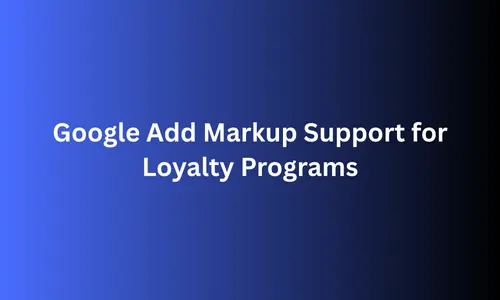Google Add Markup Support for Loyalty Programs

What is a Graphics Processing Units & Its Importance for AI
June 10, 2025
What is a Headless CMS? | Benefits and Use Cases
June 12, 2025Google’s recent introduction of markup support for loyalty programs is transforming how businesses connect with customers online. This update enables merchants to display loyalty benefits directly in search results, thereby enhancing visibility and engagement. By integrating structured data into their websites, businesses can highlight member perks like exclusive pricing, points, and free shipping, making their offerings more appealing to shoppers. This article examines the significance of this update, its benefits, and how businesses can utilize it to enhance customer relationships.
What Is Markup Support for Loyalty Programs?
Understanding Structured Data
Structured data is a standardized format that helps search engines like Google understand website content better. By adding specific tags to a site’s code, businesses can provide detailed information about their products, services, or programs. Google’s new markup support allows merchants to define loyalty programs within their organization and product data, making it easier for search engines to display these benefits prominently.
Why Loyalty Programs Matter
Loyalty programs are a proven strategy for fostering customer retention. Studies show that 85% of consumers are more likely to shop with brands offering rewards. By showcasing these perks in search results, businesses can attract more clicks and conversions, turning casual visitors into loyal customers.
Benefits of Google’s Markup Support for Loyalty Programs
Enhanced Search Visibility
With markup support, loyalty program details can appear in Google’s search results, shopping ads, and other platforms. For example, a product listing might display member-only discounts or points earned per purchase. This increased visibility helps businesses stand out in a competitive market, drawing attention to their unique offerings.
Improved Customer Engagement
When shoppers see loyalty benefits upfront, they’re more likely to engage with a brand. Highlighting perks like free shipping or exclusive pricing creates a sense of value, encouraging users to join the program or make a purchase. This direct communication builds trust and strengthens customer relationships.
Seamless Integration with Google’s Ecosystem
Google’s update integrates loyalty program data across its platforms, including Search, Shopping, and Wallet. This ensures a consistent experience for users, whether they’re browsing on desktop or mobile. For merchants, it means broader exposure without additional costs, as the loyalty add-on in Google Merchant Center is free for eligible businesses.
How to Implement Markup Support for Loyalty Programs
Step 1: Define Your Loyalty Program
Before adding markup, businesses must have a clear loyalty program structure. Decide on the rewards, such as points per dollar spent, tiered benefits, or special discounts. Ensure the program is appealing and easy to understand for your target audience. For instance, a retailer might offer “Earn 5 points per $1 spent” or “Free shipping for premium members.”
Step 2: Add Structured Data to Your Website
To use Google’s markup support, merchants need to incorporate structured data into their website’s organization and product pages. This involves adding specific tags to highlight the loyalty program’s name, benefits, and eligibility criteria. Google provides detailed guidelines to ensure compliance, and businesses can use tools like the Rich Results Test to validate their markup.
Step 3: Integrate with Google Merchant Center
For merchants in the US, UK, Australia, or Japan, Google Merchant Center offers a loyalty add-on. To activate it, navigate to the “Settings & Tools” section, select “Add-ons,” and enable the loyalty feature. Then, input program details like the name, description, and sign-up URL. This step ensures loyalty benefits are reflected across Google’s platforms.
Step 4: Test and Monitor Performance
After implementing markup, test the setup using Google’s Rich Results Test to confirm the data is valid. Monitor performance through Google Merchant Center to track how loyalty benefits impact clicks and conversions. Adjust the program as needed to maximize engagement and ROI.
Best Practices for Maximizing Loyalty Program Markup
Keep Benefits Clear and Compelling
Shoppers respond to straightforward, valuable rewards. Highlight the most attractive perks, such as “Join for free and get 10% off your first purchase” or “Earn double points on every order.” Clear communication ensures users understand the value of joining your program.
Optimize for Mobile Users
With mobile shopping on the rise, ensure your loyalty program is accessible on all devices. Google’s markup support works across desktop and mobile, but test your website’s user experience to confirm seamless enrollment and benefit redemption on smartphones.
Promote Your Program Actively
Use Google Ads to amplify your loyalty program’s visibility. For example, create campaigns that highlight member benefits in ad copy or use Customer Match to target existing loyalty members with personalized offers. This strategy drives sign-ups and encourages repeat purchases.
Stay Compliant with Google’s Guidelines
To avoid disapproval, adhere to Google’s editorial standards. Ensure member prices are the lowest available and match the currency of non-member prices. If a seasonal promotion applies, reflect the final post-promotion price in the markup to maintain accuracy.
Challenges and Considerations
Technical Expertise Required
Adding structured data requires some technical know-how. Small businesses without dedicated web developers may need to hire professionals or use plugins to implement markup correctly. However, the investment can pay off through increased visibility and sales.
Limited Geographic Availability
Currently, Google’s loyalty program markup is available only in the US, UK, Australia, and Japan. Merchants in other regions must wait for expansion or focus on alternative strategies to promote their loyalty programs.
Balancing Costs and Rewards
Running a loyalty program involves costs, such as rewards fulfillment and software maintenance. Businesses must balance these expenses with the program’s benefits, ensuring it drives enough sales to justify the investment. Analyzing performance data helps optimize the program over time.
Real-World Examples of Loyalty Program Success
Retail: Exclusive Member Discounts
A major retail chain implemented markup support to display member-only pricing in Google Shopping ads. By highlighting “10% off for loyalty members,” the retailer saw a 15% increase in click-through rates and a 20% boost in program sign-ups within three months.
E-Commerce: Points-Based Incentives
An online store used markup to showcase a points-based loyalty program, displaying “Earn 100 points per purchase” in search results. This transparency led to a 25% increase in repeat purchases, as customers were motivated to accumulate points for future rewards.
Fashion: Tiered Benefits
A fashion brand leveraged markup to promote a tiered loyalty program, with benefits like free shipping for premium members. By integrating these perks into Google’s ecosystem, the brand achieved a 30% uplift in conversions from loyalty members.
The Future of Loyalty Programs with Google
Google’s markup support for loyalty programs is a step toward a more personalized shopping experience. As artificial intelligence and machine learning evolve, we can expect Google to refine how loyalty data is displayed, possibly integrating it with voice search or augmented reality shopping. For now, businesses that adopt this update early will gain a competitive edge by reaching tech-savvy shoppers.
Google’s addition of markup support for loyalty programs is a powerful tool for businesses aiming to enhance customer loyalty and drive sales. By integrating structured data, merchants can showcase their rewards in search results, attract more clicks, and build lasting relationships with shoppers. While implementation requires effort, the benefits—improved visibility, engagement, and conversions—make it a worthwhile investment. Start exploring this update today to position your brand for success in the digital marketplace.


